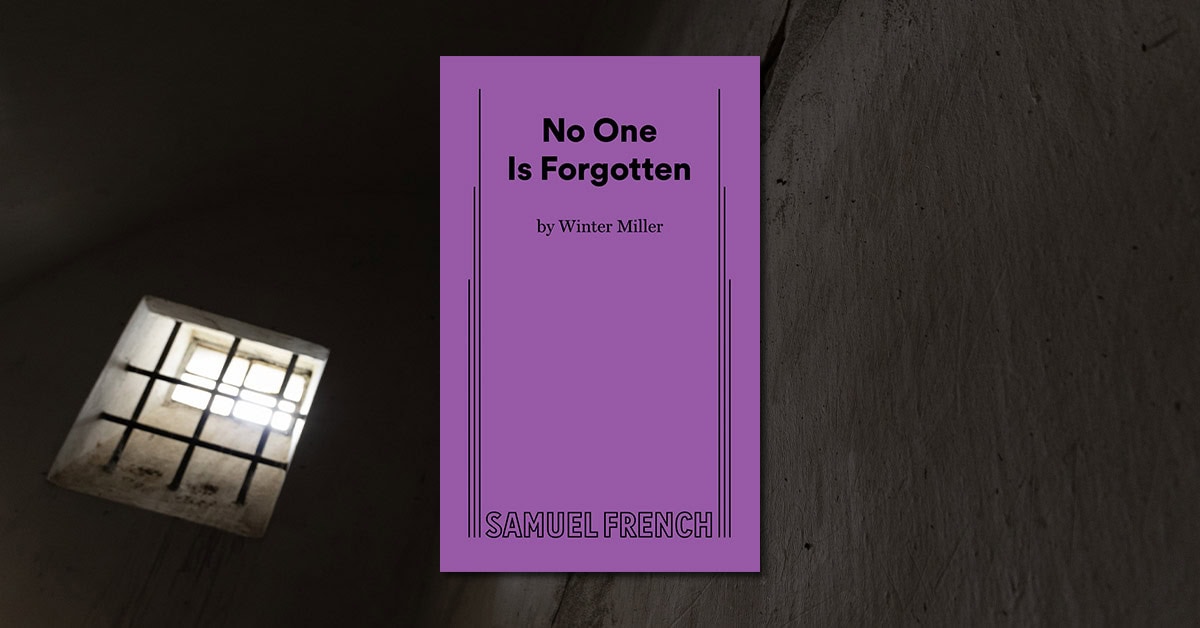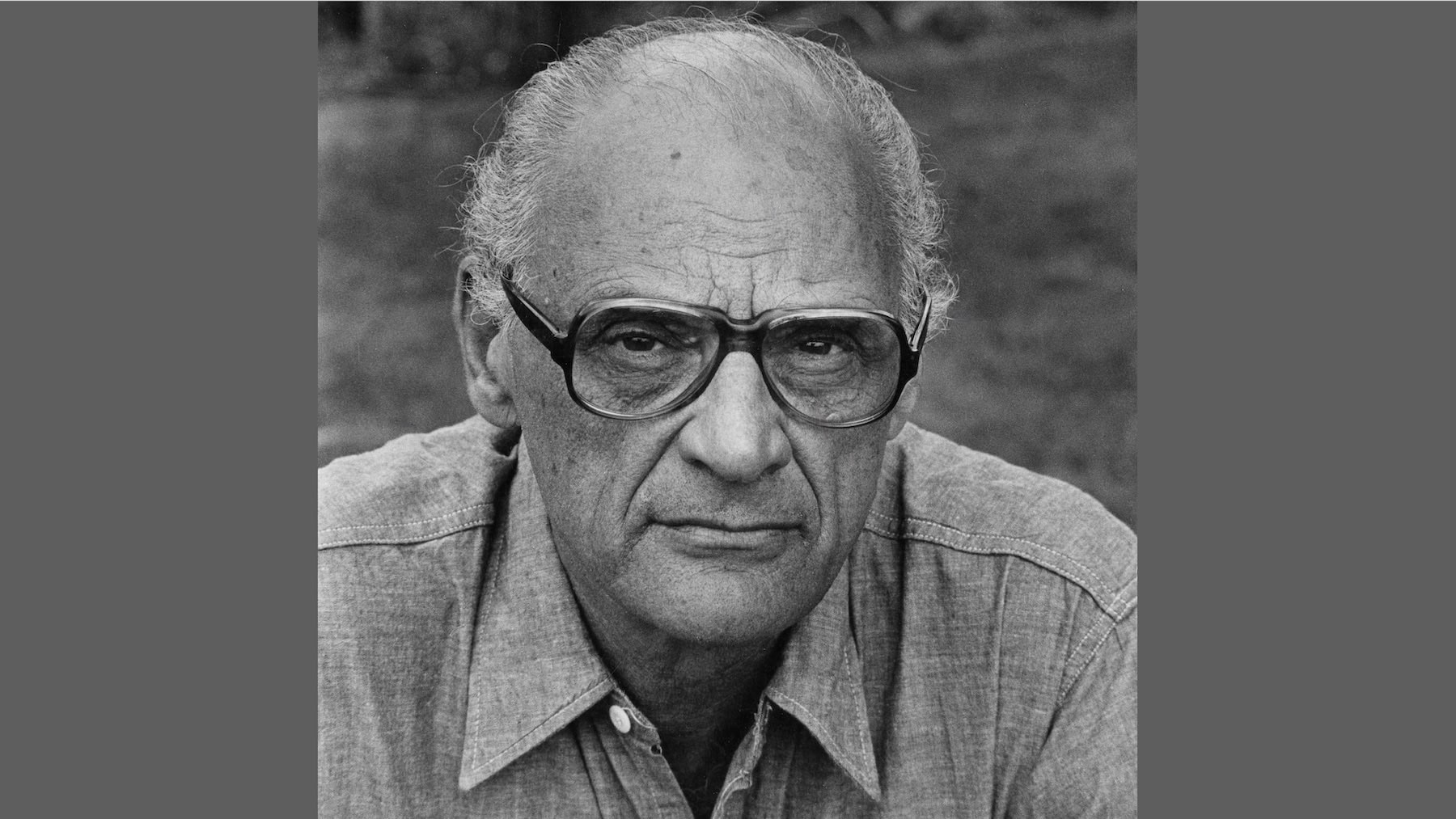
Award-winning playwright Winter Miller’s stirring two-hander No One Is Forgotten (US/UK) first appeared before audiences at off-Broadway’s Rattlestick Playwrights Theater in 2019. Since then, Miller’s dark, moving one-act, which follows the relationship between hostages Lali and Beng, has reached the hearts of an array of theatergoers. We recently connected with Miller to discuss the tender theatricality of her renowned work.
Was there a particular event that motivated you to write this play?
It simmered for a long time, but I was working at the New York Times for op-ed columnist Nick Kristof, who was covering places like Darfur in the midst of genocide, and sometimes Afghanistan and Pakistan, and it was only a few years after the Al Qaeda attacks on the US, and there was this realization of how much of the world really hates Americans for the imperialist and hypocritical wars and campaigns we’ve supported and how we’ve gone about it. It was the sins of our military at Abu Ghraib. The chaos and brutality of Gitmo. And then there was the murder of Daniel Pearl, a Wall Street Journal reporter who was captured by the Taliban and decapitated on video for all to witness. And here I was, surrounded by all these intrepid and brave New York Times reporters, and it was apparent that journalists and aid workers no longer had the immunity they once (mostly) had. They were targets. The change in the freedom of the press to work was terrifying. The stakes jumped.
Years later, I was at The Lark (RIP that great champion of writers!) and in a workshop in which a group of us had something like seven days of workshopping a new play with actors in the room. I had been jammed up a bit, not sure of what I was needing to write, and this play tumbled out of me in the seven days of the workshop, like Athena exiting Zeus’s forehead – a birth with a speedy result of a grown human. I usually write longhand and then make tons of revisions. This play demanded a keyboard and came out strong. I was listening, the play was talking.
And then, after the play was written and I was workshopping it at theaters across the country (Pssst, hey Magic Theater, hey Unicorn, hey Salt Lake City, hey every single theater that came and saw the performances as presentations by the NNPN – this play is ready for you to bring it to your home), there was a high-profile brutal murder of Jamal Khashoggi, who was a columnist for The Washington Post and editor-in-chief of Al-Arab News Channel. He was assassinated at the Saudi consulate in Istanbul in the fall of 2018; he’d gone in to get a marriage license, and agents of the Saudi government working for Prince bin Salman grabbed him, chopped him into pieces and wheeled him out in a suitcase and deposited him in the trunk of a car. This again struck terror into the hearts of journalists.
Another thing that happened as I was getting ready for the production in 2019 in NYC at Rattlestick for No One Is Forgotten is that the Orange President had stopped having morning press briefings! Also that year, the USA had been in the top three countries where journalists were unsafe – in the world! That’s terrifying for a country that is (and hopefully still will be as of next November) a democracy – that’s not supposed to happen here.
Everywhere I looked, journalists and aid workers were in peril. If you don’t have a free press, you don’t have a free country.
“The stakes are so high, and they each have to grapple with the fact that their lives are completely out of their control – except for what goes on in their minds and with each other.”
For background on your writing, what type of research did you do – perhaps conducting interviews with individuals who had experienced being held against their will?
Once I write a play, my job is to be as thorough in the research as possible about the world of the play, so that it feels authentically honest and someone who’s been in this situation can say, “I see myself.” After I had a draft, I researched and spoke with correspondents who were held hostage and survived, and I watched documentaries. The Jim Foley documentary on HBO was particularly influential; how he was in the cell according to other prisoners inspired some of Lali and Beng’s character traits. I reached out to Jim’s mother, Diane Foley, who started a foundation to help families of captured hostages, and told her about the play and she came to see it. I read reporters’ accounts of being held. One of the most meaningful compliments was from the New Yorker reporter David Rohde, a Pulitzer winner who had been held twice by the Taliban. David said to me, “Wow, it was like you were in my head.” That was the standard I was reaching for.
At one point in my life, and while I was first starting to write plays, I worked in journalism, and I always felt that playwriting and journalism are close – two sides of the same coin. As a playwright, a key to my research is interviewing people. I want the combination of the accuracy of what could authentically occur, woven into imagined emotional valences and motivations of your characters. What do they want from the person trapped in the cell with them? How far will they go to get it? In this instance, the stakes are so high, and they each have to grapple with the fact that their lives are completely out of their control – except for what goes on in their minds and with each other. Lali and Beng’s lack of privacy is a major theme in this play.
The informal and conversational style of the interactions between Lali and Beng seems to stand in stark contrast to the reality of their situation. What made you decide to just barely reference their imprisonment in their dialogue?
When I first began writing the play I didn’t know who Lali and Beng were, I don’t even know where their names came from. I didn’t know they were a reporter and an aid worker. What unfolded as I wrote the first draft is that they were two people trapped and they knew nothing about their circumstances – Who was holding them? Where were they? How long had they been captured? Would they get out alive?
Given these circumstances, what the hell do you do with someone who’s next to you 24/7 in a 7’ x 14’ cell without anything: no furniture, chalk, windows, not a speck of comfort, just a bucket to defecate in – how do you survive? Do you even want to survive? Sometimes no. This is a story about how these two characters manage to survive alone and together. You can’t live in a heightened sense like that with your entire body for months (years?) on end; your ability to metabolize danger and fear changes – it’s not one solid, static state of being. It ebbs and flows. So, when you’re bored out of your mind, what do you do to pass the time? What are the games you play?
In the Jim Foley documentary, there was a man he was in the cell with – a bunch of men actually – but one of them talked about how Jim kept him alive, taught him how to sail, by instruction and by acting it out, in their cell. My homage to Jim’s generosity of experience was to write a scene in which Lali shows Beng to windsurf in their cell. There’s actually an opera of No One Is Forgotten. Eve Gigliotti, who sings with the Met, commissioned me to write the libretto with composers Paola Prestini and Sxip Shirey. It’s a 3D spatial audio event that you can listen to wherever you get your music with a simple googling of the play’s title – put on earphones and listen to it on your couch. Their compositions and the artists involved are stunning. The windsurfing lesson is one of my favorite moments – you can feel the escape from the hell they’re in.
“I rarely if ever see women physically fighting with each other onstage – men do all the time – but we don’t produce stories about violence and sex between women.”
Tell me about your decision to introduce intimacy between Lali and Beng. Do you think this experience was purely physical for them or did it build on their eventual reliance on each other?
I think if you’re with someone in a cell for months or years, you turn to them for physical contact of all kinds – hugging, wrestling, cuddling – but also, sex is intimacy for some and a necessary physical release for others. In this instance, Beng is a lesbian and Lali is heterosexual. They both have significant others, but they are far from home. They need each other to survive. So, while Beng falls in love with Lali first, for Lali, over the course of time, the sex changes from something that is an animalistic need to an emotional connection. There are two moments of sexual intimacy shown between them. The first sex we witness is a physical release for them, a reminder that they are humans with bodies. The one later looks and feels different – it’s initiated by Lali, and it represents that she’s come to love and want Beng. They are bonded for life over their captivity. They love and hate each other. It was interesting to have the pandemic follow on the heels of this first production. This story is a higher-stakes version than the experiences people reported of feeling trapped together in relationships and apartments.
I think it’s important to relate the required physicality and athleticism of these roles. They’re physical women in general; Lali exercises to keep herself sane and they physically fight with one another. As a playwright and an audience-goer, I rarely if ever see women physically fighting with each other onstage – men do all the time – but we don’t produce stories about violence and sex between women. Before I wrote this, I can’t say I have ever seen a physical sex scene between women that is right in front of you and is not hidden beneath a sheet – like somebody’s head dips down under the sheet and the audience is like, oh right, we can’t see it, but we know what that is, that’s oral sex. I wanted to show body-on-body, full-body contact between two women as they have sex. They’re not ever naked, but it’s the way they hike up their shifts and their bodies connect. I want actors to be able to be that liberated – in this play you cannot hide. It’s a single set the size of a postage stamp. I directed it with audiences on all four sides, and the first row was three feet away from the actors when they were at the edge of their cell. Sex is a part of life, it’s a part of theirs too. And sex doesn’t always look the same, because people and circumstances change.
A lot of the play’s dialogue is laced with humor. Why do you think it was important to include this dimension in their banter?
This is who I am as a person and a writer. At some point, the worst things in life are also funny – whether that takes time or just someone revealing the flipside. If you read Anne Frank’s diary, she was not only devastatingly astute, she was funny. This play trades on gallows humor because Lali and Beng need it to survive. Their games are sometimes morbid, like asking each other to vote on the worst ways of dying, such as death by concentration camp or gulag. Being trapped in a cell with no windows and your cellmate gets a cramp and you offer to run out and get them bananas and ask if there’s anything else they’d like, and they say, “Mrs. Dash, two sponges – one for dishwashing, Pampers.” These two surprise each other with their playfulness in order to survive the bleakness of their terrifying existence.
“I wanted to drive home that we no longer have freedom of the press. That’s more serious than it’s ever been.”
Do you think audiences are going to want to know more about the crimes that Lali and Beng supposedly committed and where they are being held and by whom? Did you make an active choice from the get-go to leave these details out of the story?
Oh, they didn’t commit crimes! I love this question! What a great interpretation! What I’m getting at is that they were working – as a foreign correspondent and an aid worker – and those two things, and their American passports, no longer guarantee someone immunity from being shot at or taken hostage. I wanted to drive home that we no longer have freedom of the press. That’s more serious than it’s ever been. Think about inexperienced freelance reporters being sent out to cover wars. They are even less protected than someone who works for the Times.
Any feeling of despair in the story seems to be minimized. I’m curious to hear about your crafting of these two characters as strong and sturdy with seemingly few cracks in their resilience.
I think they do have significant cracks – how could they not? – but often those are the things they are withholding from each other. They are, in a sense, keeping each other alive. They’ve come up with their own rules about what they will and won’t talk about, because they are trying to preserve their sanity and their ability to cultivate hope. If they both lose it at the same time, what happens? In the same way, each of them in their own mind might be thinking, “Let me die first so I don’t experience the loss of the other, but let them die first so they don’t have to live without me.” Like the rest of us, they are generous and selfish.
When Beng tries to hurt herself and Lali blurts out “I need you,” do you find this is a moment of awakening for audiences to see what has turned into love between these two women?
Yeah, they each have different types of walls they’ve put up to salvage parts of themselves that are their last bastions of selfhood, the deep recesses of their minds. They can read each other immediately, so part of their struggle is to not become the other person, to keep some sense of privacy. This is as important as being connected, some feeling of personal space where the other person can’t penetrate. But yes, that is a moment where we see Lali break, that she’s crossed a threshold into really admitting she needs Beng and that she wants Beng.
“Watching the audience decide for themselves is intriguing… hearing what they believe to be true.”
The play’s ending is left ambiguous. Why dId you decide to leave the audience wondering about the fate of Beng and Lali?
Ribbons and bows are for presents not plays. Watching the audience decide for themselves is intriguing, hearing what they believe to be true – it’s the afterlife? It’s freedom? It’s the prelude to their death? I don’t know that the actors make decisions that are locked in place. I don’t want to decide that for you. In those last moments they’re taking it one moment at a time. It’s also one of the most beautiful light cues I’ve ever seen anywhere.
What about the prospect of staging No One Is Forgotten do you hope will inspire directors?
It’s bold. There’s nowhere to hide, no stage business to do. The proximity, the physicality, the fighting, the sex, the timing. This is a play for everyone involved – the actors, director, the full design crew and the stage manager and the assistant stage manager, the intimacy/fight director – to elevate the script and bring this drama to fruition. For me, witnessing a creative team inhabit the world of this play was remarkable, the teamwork and precision. There’s a magic trick of disappearing and reappearing that if you do it with an audience surrounding the stage, it’s a glorious bit of theatricality.
Every night, audiences would gasp and look around in shock – pulling off sleight of hand in a tight space is truly thrilling. Most of all, it’s also a play you can put together on a budget quite effectively: two characters, a single set is an empty cell falling apart, costumes are shifts. Show me something this cheap to produce with this level of theatricality. I think it takes tenacity, a mission to show audiences things they aren’t likely to see, right alongside the familiarities of love – between friends and romantically. And if you’re someone who has hope as a practice, this play is for you.
Whose works would say have influenced your work as a playwright, particularly on crafting No One Is Forgotten?
For sure, Caryl Churchill’s Far Away. What that play accomplishes in 45 pages with two- or three-character scenes is extraordinary and terrifying! It’s absurd! It’s metaphorical. Not a word is wasted nor are there any extra ruffles. I am perpetually obsessed with Churchill. She reminds me of what it’s possible to create, and without massive budgets and stage pictures.
There are dozens of playwrights who influence my writing, but I’m often looking at a particular play by a playwright and asking, how did they do that? What do I want to do? What’s the story I want to tell, and what is the architecture or structure of it? Who are the characters, what will they die for and what does that look like? How do you tap into people’s innate humanity and grace?
Maria Irene Fornes is always an influence – as much as for what she leaves out as for what she includes. Also, her embrace of extremes, banalities, life’s absurdities, and incongruencies. I think there’s also shades of Godot and Kiss of the Spider Woman in there, not tonally, but with the sense of being stuck in place. My peers influence me – there are too many to mention and also to risk leaving someone out!
Often, designers influence me when I’m writing – two whom I’ve known and admired for years are Jane Cox and Rachel Hauck. They recommended Stacey DeRosier and Meredith Ries, who worked with our incredible DP, Lory Henning – a gem and a whiz at building out the set. With Tyler Keiffer creating sound and Rhys Roffee designing costumes, we had a very strong design team. They inspired me. Also, in rewrites for production, I was writing to the strengths of the actors, Sarah Nina Hayon and Renata Friedman, two very physical, fearless, hilarious and powerful women.
“The story is a love letter to the human spirit, and our resilience.”
Why do you think No One Is Forgotten is a good fit for high school and college theatre programs?
No One Is Forgotten is a strong pick for artists who want to strengthen their design and directing skills and elevate their collaboration. So much of theater is being able to work with others and share a vision you create together. I haven’t met every high school and college student, but I’m going to guess that for many, this play is probably like nothing they’ve seen. It’s a great challenge for strivers; it balances intimacy, humor, fear, despair and the will to live. The story is a love letter to the human spirit, and our resilience. It’s a chance for directors and a team of artists to wow their community. It’s also convenient because you have rehearsals with only two actors, so you can really work your craft in ways that are different from a ten-character play. These actors get all your focus. For actors, it’s a chance to sink your teeth in and go all out.
What do you hope an audience will take away from seeing a production of No One Is Forgotten?
I believe it’s important to see work that doesn’t tie an ending up in a bow for you, where you walk out wondering, “How do I think this ends?” I think for current audiences, it’s impossible to avoid thinking about the pandemic, early on, when people were newly trapped and terrified, and as the pandemic wore on, how challenging it was to be with someone you really loved, or really didn’t – intimacy was really put to the test. I hope audiences will wonder about what they’d do in this situation, which character they might be, or what it might feel like to be the family members of these two, and you haven’t heard from them in however long it’s been. And I hope audiences will monitor the levels of freedom of the press globally – where are reporters or aid workers banned entry? What’s the health of our nation as it relates to a free press? Who can we trust to tell us an unbiased, unbought truth?
For information on producing No One Is Forgotten, visit Concord Theatricals in the US or UK.

Community Theatre: Consider These Plays & Musicals, 2025-26

Arthur Miller In Five Plays

